Simon Malinowski
LinkMedia, UR1
MAAIP: Multi-Agent Adversarial Interaction Priors for imitation from fighting demonstrations for physics-based characters
Nov 04, 2023



Abstract:Simulating realistic interaction and motions for physics-based characters is of great interest for interactive applications, and automatic secondary character animation in the movie and video game industries. Recent works in reinforcement learning have proposed impressive results for single character simulation, especially the ones that use imitation learning based techniques. However, imitating multiple characters interactions and motions requires to also model their interactions. In this paper, we propose a novel Multi-Agent Generative Adversarial Imitation Learning based approach that generalizes the idea of motion imitation for one character to deal with both the interaction and the motions of the multiple physics-based characters. Two unstructured datasets are given as inputs: 1) a single-actor dataset containing motions of a single actor performing a set of motions linked to a specific application, and 2) an interaction dataset containing a few examples of interactions between multiple actors. Based on these datasets, our system trains control policies allowing each character to imitate the interactive skills associated with each actor, while preserving the intrinsic style. This approach has been tested on two different fighting styles, boxing and full-body martial art, to demonstrate the ability of the method to imitate different styles.
* SCA'23, Supplementary video: https://youtu.be/wQfIiw_rQ3w
Temporal Disaggregation of the Cumulative Grass Growth
Dec 21, 2022Abstract:Information on the grass growth over a year is essential for some models simulating the use of this resource to feed animals on pasture or at barn with hay or grass silage. Unfortunately, this information is rarely available. The challenge is to reconstruct grass growth from two sources of information: usual daily climate data (rainfall, radiation, etc.) and cumulative growth over the year. We have to be able to capture the effect of seasonal climatic events which are known to distort the growth curve within the year. In this paper, we formulate this challenge as a problem of disaggregating the cumulative growth into a time series. To address this problem, our method applies time series forecasting using climate information and grass growth from previous time steps. Several alternatives of the method are proposed and compared experimentally using a database generated from a grassland process-based model. The results show that our method can accurately reconstruct the time series, independently of the use of the cumulative growth information.
Learning Interpretable Shapelets for Time Series Classification through Adversarial Regularization
Jun 12, 2019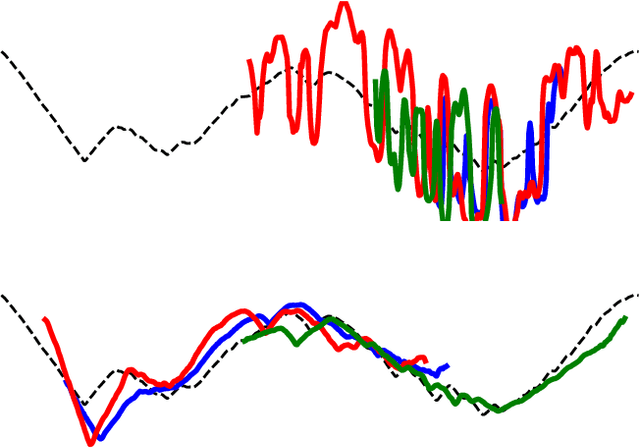

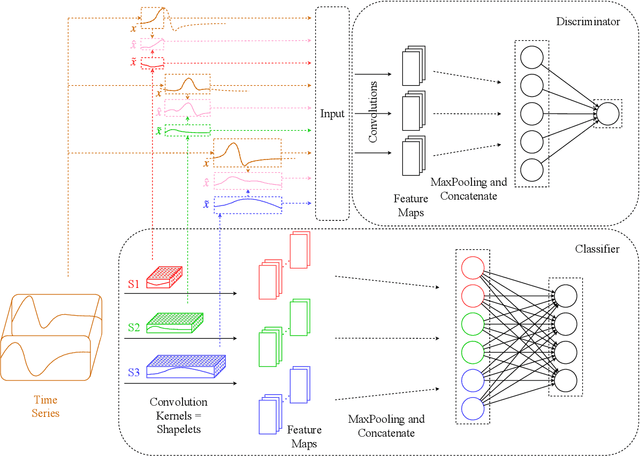
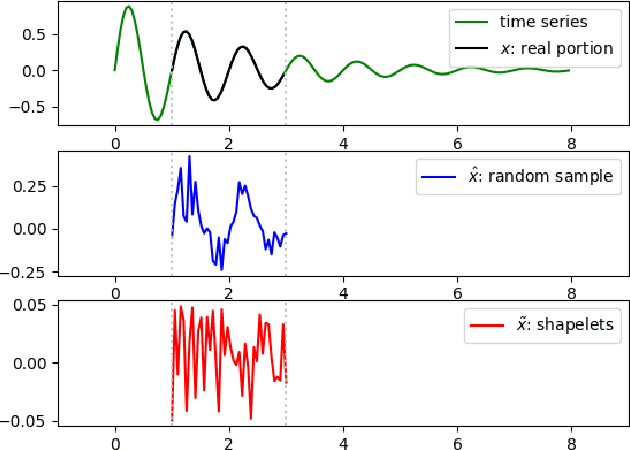
Abstract:Times series classification can be successfully tackled by jointly learning a shapelet-based representation of the series in the dataset and classifying the series according to this representation. However, although the learned shapelets are discriminative, they are not always similar to pieces of a real series in the dataset. This makes it difficult to interpret the decision, i.e. difficult to analyze if there are particular behaviors in a series that triggered the decision. In this paper, we make use of a simple convolutional network to tackle the time series classification task and we introduce an adversarial regularization to constrain the model to learn more interpretable shapelets. Our classification results on all the usual time series benchmarks are comparable with the results obtained by similar state-of-the-art algorithms but our adversarially regularized method learns shapelets that are, by design, interpretable.
Day-ahead time series forecasting: application to capacity planning
Nov 06, 2018


Abstract:In the context of capacity planning, forecasting the evolution of informatics servers usage enables companies to better manage their computational resources. We address this problem by collecting key indicator time series and propose to forecast their evolution a day-ahead. Our method assumes that data is structured by a daily seasonality, but also that there is typical evolution of indicators within a day. Then, it uses the combination of a clustering algorithm and Markov Models to produce day-ahead forecasts. Our experiments on real datasets show that the data satisfies our assumption and that, in the case study, our method outperforms classical approaches (AR, Holt-Winters).
From BOP to BOSS and Beyond: Time Series Classification with Dictionary Based Classifiers
Sep 18, 2018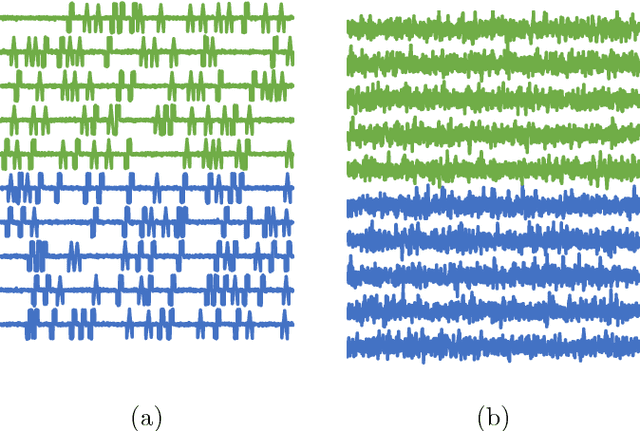

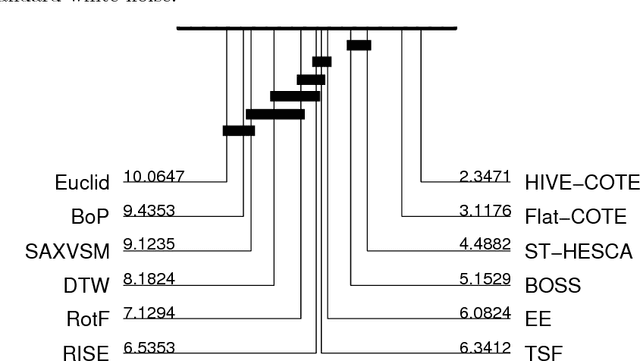

Abstract:A family of algorithms for time series classification (TSC) involve running a sliding window across each series, discretising the window to form a word, forming a histogram of word counts over the dictionary, then constructing a classifier on the histograms. A recent evaluation of two of this type of algorithm, Bag of Patterns (BOP) and Bag of Symbolic Fourier Approximation Symbols (BOSS) found a significant difference in accuracy between these seemingly similar algorithms. We investigate this phenomenon by deconstructing the classifiers and measuring the relative importance of the four key components between BOP and BOSS. We find that whilst ensembling is a key component for both algorithms, the effect of the other components is mixed and more complex. We conclude that BOSS represents the state of the art for dictionary based TSC. Both BOP and BOSS can be classed as bag of words approaches. These are particularly popular in Computer Vision for tasks such as image classification. Converting approaches from vision requires careful engineering. We adapt three techniques used in Computer Vision for TSC: Scale Invariant Feature Transform; Spatial Pyramids; and Histrogram Intersection. We find that using Spatial Pyramids in conjunction with BOSS (SP) produces a significantly more accurate classifier. SP is significantly more accurate than standard benchmarks and the original BOSS algorithm. It is not significantly worse than the best shapelet based approach, and is only outperformed by HIVE-COTE, an ensemble that includes BOSS as a constituent module.
Dense Bag-of-Temporal-SIFT-Words for Time Series Classification
Jan 13, 2016



Abstract:Time series classification is an application of particular interest with the increase of data to monitor. Classical techniques for time series classification rely on point-to-point distances. Recently, Bag-of-Words approaches have been used in this context. Words are quantized versions of simple features extracted from sliding windows. The SIFT framework has proved efficient for image classification. In this paper, we design a time series classification scheme that builds on the SIFT framework adapted to time series to feed a Bag-of-Words. We then refine our method by studying the impact of normalized Bag-of-Words, as well as densely extract point descriptors. Proposed adjustements achieve better performance. The evaluation shows that our method outperforms classical techniques in terms of classification.
Event and Anomaly Detection Using Tucker3 Decomposition
Jun 12, 2014



Abstract:Failure detection in telecommunication networks is a vital task. So far, several supervised and unsupervised solutions have been provided for discovering failures in such networks. Among them unsupervised approaches has attracted more attention since no label data is required. Often, network devices are not able to provide information about the type of failure. In such cases the type of failure is not known in advance and the unsupervised setting is more appropriate for diagnosis. Among unsupervised approaches, Principal Component Analysis (PCA) is a well-known solution which has been widely used in the anomaly detection literature and can be applied to matrix data (e.g. Users-Features). However, one of the important properties of network data is their temporal sequential nature. So considering the interaction of dimensions over a third dimension, such as time, may provide us better insights into the nature of network failures. In this paper we demonstrate the power of three-way analysis to detect events and anomalies in time-evolving network data.
 Add to Chrome
Add to Chrome Add to Firefox
Add to Firefox Add to Edge
Add to Edge